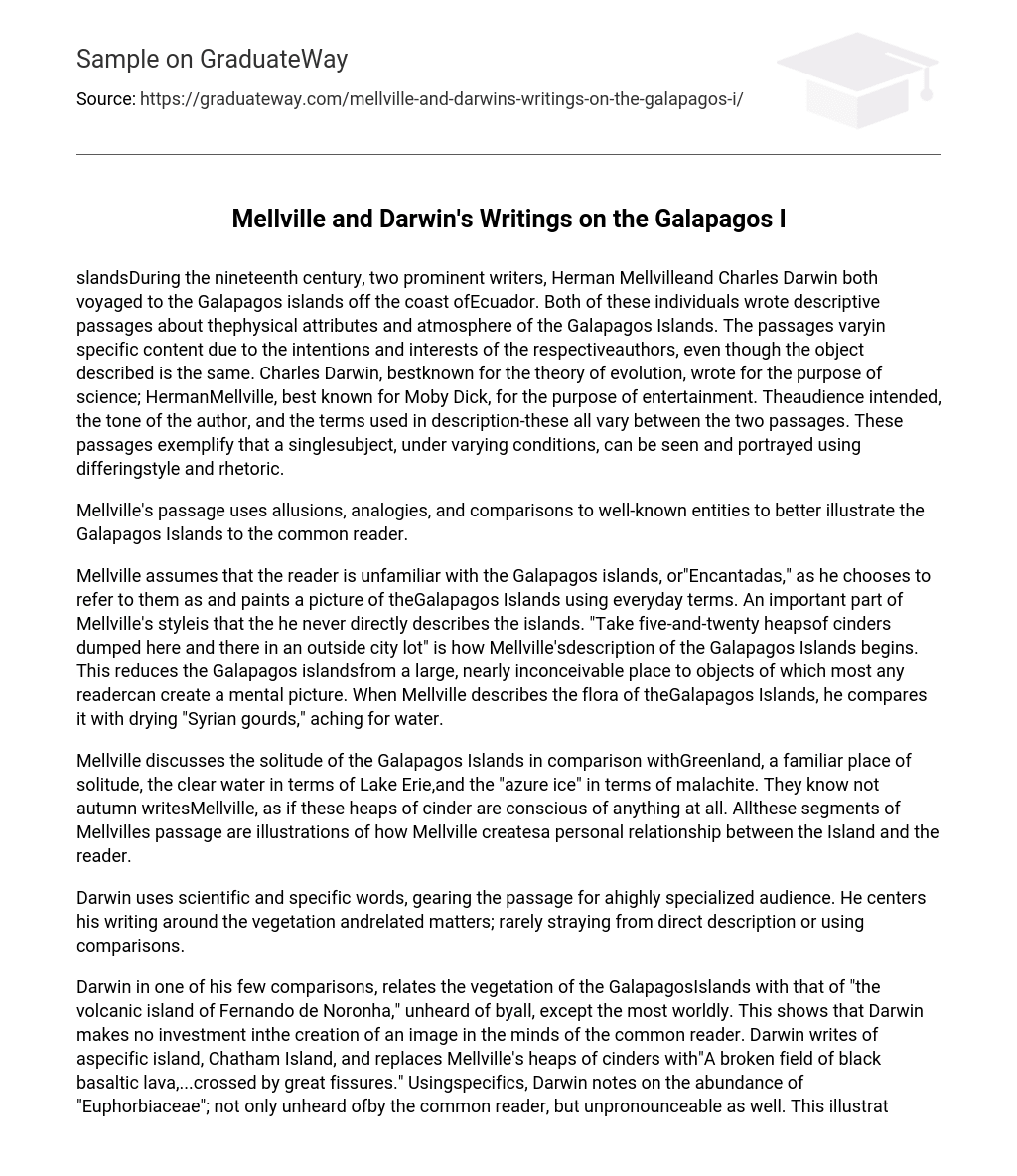slandsDuring the nineteenth century, two prominent writers, Herman Mellvilleand Charles Darwin both voyaged to the Galapagos islands off the coast ofEcuador. Both of these individuals wrote descriptive passages about thephysical attributes and atmosphere of the Galapagos Islands. The passages varyin specific content due to the intentions and interests of the respectiveauthors, even though the object described is the same. Charles Darwin, bestknown for the theory of evolution, wrote for the purpose of science; HermanMellville, best known for Moby Dick, for the purpose of entertainment. Theaudience intended, the tone of the author, and the terms used in description-these all vary between the two passages. These passages exemplify that a singlesubject, under varying conditions, can be seen and portrayed using differingstyle and rhetoric.
Mellville’s passage uses allusions, analogies, and comparisons to well-known entities to better illustrate the Galapagos Islands to the common reader.
Mellville assumes that the reader is unfamiliar with the Galapagos islands, or”Encantadas,” as he chooses to refer to them as and paints a picture of theGalapagos Islands using everyday terms. An important part of Mellville’s styleis that the he never directly describes the islands. “Take five-and-twenty heapsof cinders dumped here and there in an outside city lot” is how Mellville’sdescription of the Galapagos Islands begins. This reduces the Galapagos islandsfrom a large, nearly inconceivable place to objects of which most any readercan create a mental picture. When Mellville describes the flora of theGalapagos Islands, he compares it with drying “Syrian gourds,” aching for water.
Mellville discusses the solitude of the Galapagos Islands in comparison withGreenland, a familiar place of solitude, the clear water in terms of Lake Erie,and the “azure ice” in terms of malachite. They know not autumn writesMellville, as if these heaps of cinder are conscious of anything at all. Allthese segments of Mellvilles passage are illustrations of how Mellville createsa personal relationship between the Island and the reader.
Darwin uses scientific and specific words, gearing the passage for ahighly specialized audience. He centers his writing around the vegetation andrelated matters; rarely straying from direct description or using comparisons.
Darwin in one of his few comparisons, relates the vegetation of the GalapagosIslands with that of “the volcanic island of Fernando de Noronha,” unheard of byall, except the most worldly. This shows that Darwin makes no investment inthe creation of an image in the minds of the common reader. Darwin writes of aspecific island, Chatham Island, and replaces Mellville’s heaps of cinders with”A broken field of black basaltic lava,…crossed by great fissures.” Usingspecifics, Darwin notes on the abundance of “Euphorbiaceae”; not only unheard ofby the common reader, but unpronounceable as well. This illustrates that theintended readers of Darwin’s passage are perhaps botanists or biologists. As ifin a laboratory report or scientific analysis, Darwin describes the physicalelement of the Galapagos Islands, rarely straying into emotions.
Varying themes found in the diction of the two passages createsdifferent overall impressions for the reader. In Darwin’s diction, one finds anobvious theme, the repeated use of words involving heat. “Lava,” “sun-burnt,””dry,””parched,” “heated,”sun” and “stove” are all used within the first foursentences. It is not uncommon to find a subject-verb-complement structure onlyslightly modified; Nothing could be less inviting than the first appearance.
is a example of this. Primarily, Darwin uses mild variations on the simplesentence structure; Mellville, varied structures. The third paragraph ofMellville’s passage consists solely of one long sentence, formed by pilingimages:And as for solitariness; the great forests of the north, the expanses ofunnavigated waters, the Greenland icefields, are the profoundest of solitudes toa human observer; still the magic of their changeable tides and seasonsmitigates their terror; because, though unvisited by men, those forests arevisited by the May; the remotest seas reflect stars even as Lake Erie does; andin the clear air of a fine polar day, the irradiated azure ice shows beautifullyas malachite.
This sentence, both in complexity and uniquity, displays the immense variationsin sentence structure at Mellville’s disposal.
The mood of Mellville’s entire passage is both sad and lonely; wordsthroughout the passage display this: “solitariness,” “solitudes,” “desolation,””sympathy,” “sorrows” and “sad.” Mellville awakens thoughts of sympathy as hecompares The Encantadas with withering cities and disheveled cemeteries.
Towards the end, Mellville displays this superbly, Have mercy on me,’ thewailing spirit of the Encantadas seems to cry. With emotion andpersonification, Mellville approaches the Galapagos Islands poetically. Hedescribes the terror as well as the solitude experienced on the islands; givingthe reader a sense of atmosphere.
In conclusion, these points demonstrate possible ways to relate asubject to a reader using varied style and rhetoric. Such drastic differencescan be found elsewhere as well. The Bible outlines rules and restrictions forits followers to live by; books of law, rules for all who live in the UnitedStates. Even though there are major differences found between passages ofDarwin and Mellville, similar to those between the Bible and formal law books,there are obvious similarities. Both passages talk of the scattered black hillsthat form the Galapagos Islands. Both portray an uninviting island; Darwinwrites: “We fancied that even the bushes smelt unpleasantly.” The use of “even”by Darwin implies that other objects on the island emit a stench as well. With asimilar outlook, Mellville writes: “ruin itself can work little more upon them.”These passages, both written about the Galapagos Islands, have many significantdifferences, as well as some similarities. They demonstrate contrasting ways toperceive and relate a subject as well as the Bible and books of law.
Category: English





